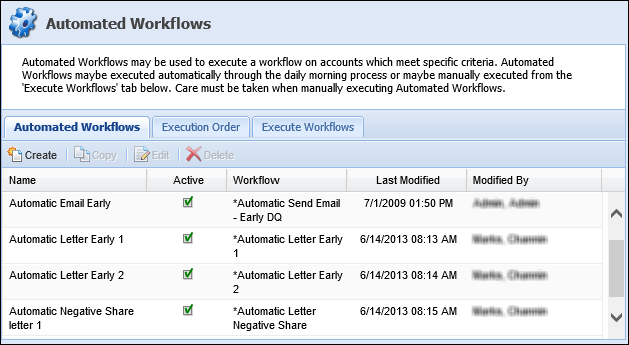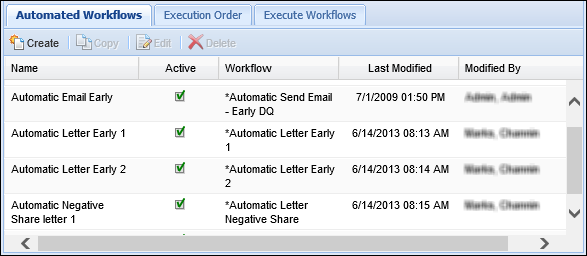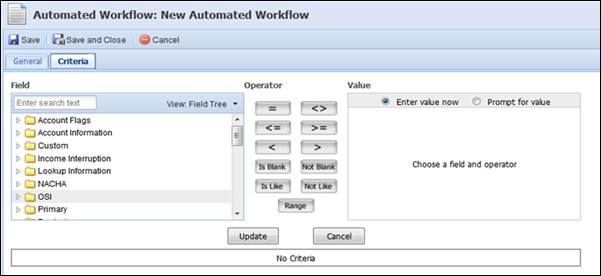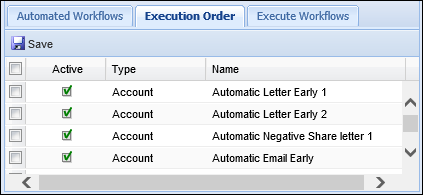Automated Workflows are used to automatically execute a workflow on accounts or cases that meet specified criteria. Administrators can select workflows built within the Framework to be automated and executed daily during the morning batch process. Automated workflows are managed in the System Managment > Workflows > Automated Workflow page.
There are three tabs displayed within this page: Automated Workflows, Execution Order and Execute Workflows.

 |
Only workflows that have automated steps can be used in automated workflows. If a manual step is included in an automated workflow, the workflow is “suspended” and is marked as Active on the Workflow History screen in the workspace. |
For a list of workflow steps that are automated, please see the Workflow Steps section of the End User Guide.
Automated Workflows
All automated workflows within the Framework are managed from the Automated Workflows tab. This tab is displayed by default when opening the Automated Workflows page in System Management.

The following columns display within the Automated Workflows tab:
| Column Name | Description |
| Name | Displays the name of the automated workflow. |
| Active | Displays a  if the automated workflow is active in the Framework. if the automated workflow is active in the Framework. |
| Workflow | Displays the name of the workflow that is run as a part of the automated workflow. |
| Last Modified | Denotes when the last modification was made. |
| Modified By | Denotes who made the last modification. |
Automated Workflow Attributes
All automated workflows share common attributes that are defined while creating, copying or editing an automated workflow.
General
General attributes provide administrators with the ability to define the basic information pertaining to automated workflows.

The following attributes are located on the General tab:
| Attribute | Description |
| Automated Workflow Name | Enter a name for the automated workflow. This field is required. |
| Description | If desired, enter additional details about the automated workflow. |
| Active | Select this check box to activate the automated workflow in the Framework. |
| Required Element | From the drop-down, select the level in which the automated workflow runs (Account or Case). |
| Workflow | From the drop-down, select the workflow to run as a part of the automated workflow. |
Criteria
Criteria attributes provide administrators with the ability to determine on which accounts and persons the automated workflow runs by using the Framework's standard criteria builder.
 |
For more information on the criteria builder available in the Framework, please see the Criteria Builder Help topic of the Framework Administrator Guide. |
 |
Primary fields, not Person fields, are available when setting the criteria for an automated workflow. |

Creating an Automated Workflow
- To create an automated workflow, click Create on the Automated Workflows tab.
- The New Automated Workflow screen appears. Define any necessary attributes for the automated workflow.
- When finished entering all information, click Save or Save and Close to save the new automated workflow and return to the Automated Workflows page. The new automated workflow populates in the list and runs during the daily process. Click Cancel to return to the Automated Workflows page without saving.
Copying an Automated Workflow
- To copy an automated workflow, select an automated workflow within the Automated Workflows tab and click Copy.
- The Copy Automated Workflow screen appears. Make any necessary changes to the automated workflow.
- When finished entering all information, click Save or Save and Close to save the new automated workflow and return to the Automated Workflows page. The new automated workflow populates in the list and runs during the daily process. Click Cancel to return to the Automated Workflows page without saving.
Editing an Automated Workflow
- To edit an automated workflow, select an automated workflow within the Automated Workflows tab and click Edit.
- The Edit Automated Workflow screen appears. Make any necessary changes to the automated workflow.
- When finished entering all information, click Save or Save and Close to save the automated workflow and return to the Automated Workflows page. Click Cancel to return without saving.
Deleting an Automated Workflow
- To delete an automated workflow, select an automated workflow within the Automated Workflows tab and click Delete.
- A confirmation message appears. Click Yes to delete the automated workflow. Click No to retain the automated workflow and return to the Automated Workflows page.
Automated Workflow Tips and Tricks
Automated workflows can be configured as a part of a multi-account workflow or a single-account workflow. When ran as a single-account versus a multi-account workflow, different results are produced. A good example of this is incorporating a send letter or send email workflow step as a part of an automated workflow.
- If the send letter or send email workflow step is incorporated as a part of a multi-account automated workflow, all of the account's information populates on one letter or email and the primary recipient receives one letter or email.
- If the send letter or send email workflow step is incorporated as a part of a single-account automated workflow, a separate letter or email is sent for each account and only contains that account’s specific information.
- When an automated letter or email workflow is run on an account, a single letter or email is generated for each related person on each account based on the roles configured for the letter or email.
Execution Order
Administrators can set the order in which automated workflows are executed within the Execution Order tab. This feature is useful if an account meets criteria for multiple workflows. A higher workflow in the list on the Execution Order tab takes precedence over a workflow that is lower in the list.

The following columns display within the Execution Order tab:
| Column Name | Description |
| Active | Displays a  if the automated workflow is active in the Framework. if the automated workflow is active in the Framework. |
| Type | Displays the level in which the automated workflow runs (Account or Case). |
| Name | Displays the name of the automated workflow. |
Arranging the Execution Order
- To rearrange the automated workflow execution order, select one or more automated workflows to be moved.
- Click and drag the automated workflow to its desired location within the workflows list. A green check mark appears when the location is an acceptable place to relocate the workflow.
- When finished rearranging the order, click Save. A success message appears indicating the changes were saved successfully.
Execute Workflows
Administrators can manually execute automated workflows outside of the normal daily processing through the Execute Workflows tab.

The following columns display on the Execute Workflows tab:
| Column Name | Description |
| Workflow | Displays the name of the automated workflow. |
| Account | Displays the number of accounts that were affected by the Preview or Execute functions. |
| Cases | Displays the number of cases that were affected by the Preview or Execute functions. |
From the Execute Workflows tab, administrators can manually Preview and Execute automated workflows.
Previewing an Automated Workflow
Previewing an automated workflow provides an administrator with the ability to assess the number of accounts or cases that would be affected if the automated workflow was executed at this point in time.
- To preview an automated workflow, select the automated workflow within the list and click Preview.
- A message appears indicating that the preview is complete and the list of workflows on the Execute Workflows tab is updated with the number of accounts or cases that would be affected by executing the automated workflow(s).
Executing an Automated Workflow
- To execute an automated workflow outside of daily processing, select the automated workflow within the list and click Execute.
- A message appears indicating that the workflow execution is complete and the list of workflows on the Execute Workflows tab is updated with the number of accounts or cases that were affected by the automated workflow execution. The Workflow History screen is also updated to reflect the execution of the workflow.
